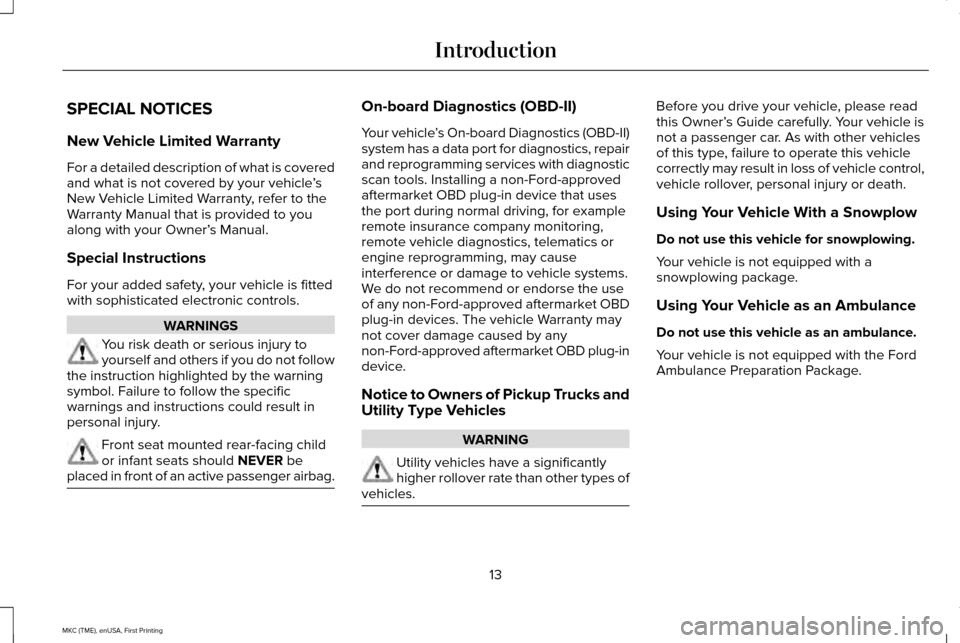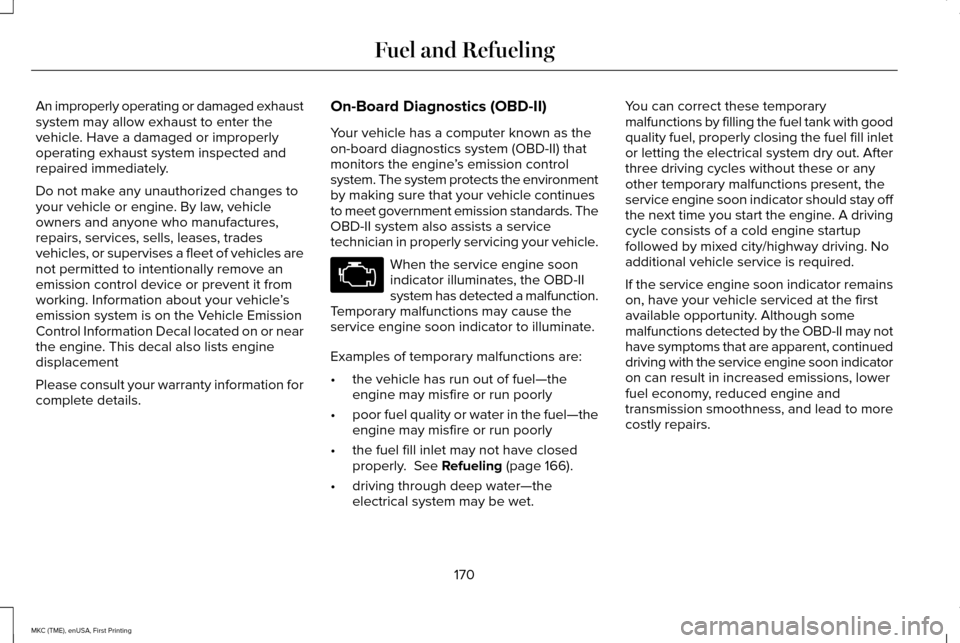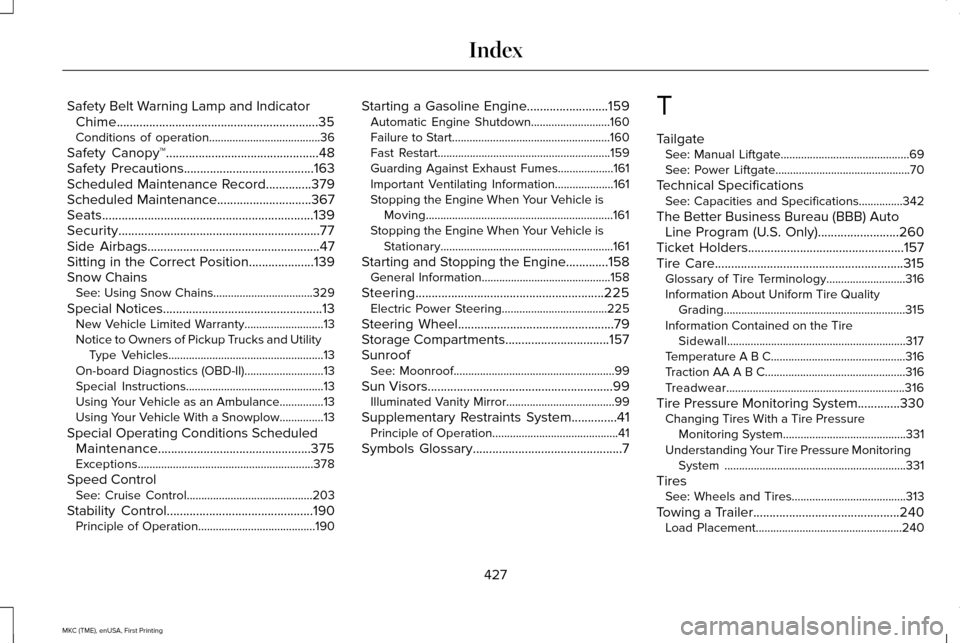OBD port LINCOLN MKC 2016 Owners Manual
[x] Cancel search | Manufacturer: LINCOLN, Model Year: 2016, Model line: MKC, Model: LINCOLN MKC 2016Pages: 432, PDF Size: 4.89 MB
Page 16 of 432

SPECIAL NOTICES
New Vehicle Limited Warranty
For a detailed description of what is covered
and what is not covered by your vehicle
’s
New Vehicle Limited Warranty, refer to the
Warranty Manual that is provided to you
along with your Owner’ s Manual.
Special Instructions
For your added safety, your vehicle is fitted
with sophisticated electronic controls. WARNINGS
You risk death or serious injury to
yourself and others if you do not follow
the instruction highlighted by the warning
symbol. Failure to follow the specific
warnings and instructions could result in
personal injury. Front seat mounted rear-facing child
or infant seats should NEVER be
placed in front of an active passenger airbag. On-board Diagnostics (OBD-II)
Your vehicle
’s On-board Diagnostics (OBD-II)
system has a data port for diagnostics, repair
and reprogramming services with diagnostic
scan tools. Installing a non-Ford-approved
aftermarket OBD plug-in device that uses
the port during normal driving, for example
remote insurance company monitoring,
remote vehicle diagnostics, telematics or
engine reprogramming, may cause
interference or damage to vehicle systems.
We do not recommend or endorse the use
of any non-Ford-approved aftermarket OBD
plug-in devices. The vehicle Warranty may
not cover damage caused by any
non-Ford-approved aftermarket OBD plug-in
device.
Notice to Owners of Pickup Trucks and
Utility Type Vehicles WARNING
Utility vehicles have a significantly
higher rollover rate than other types of
vehicles. Before you drive your vehicle, please read
this Owner’
s Guide carefully. Your vehicle is
not a passenger car. As with other vehicles
of this type, failure to operate this vehicle
correctly may result in loss of vehicle control,
vehicle rollover, personal injury or death.
Using Your Vehicle With a Snowplow
Do not use this vehicle for snowplowing.
Your vehicle is not equipped with a
snowplowing package.
Using Your Vehicle as an Ambulance
Do not use this vehicle as an ambulance.
Your vehicle is not equipped with the Ford
Ambulance Preparation Package.
13
MKC (TME), enUSA, First Printing Introduction
Page 173 of 432

An improperly operating or damaged exhaust
system may allow exhaust to enter the
vehicle. Have a damaged or improperly
operating exhaust system inspected and
repaired immediately.
Do not make any unauthorized changes to
your vehicle or engine. By law, vehicle
owners and anyone who manufactures,
repairs, services, sells, leases, trades
vehicles, or supervises a fleet of vehicles are
not permitted to intentionally remove an
emission control device or prevent it from
working. Information about your vehicle
’s
emission system is on the Vehicle Emission
Control Information Decal located on or near
the engine. This decal also lists engine
displacement
Please consult your warranty information for
complete details. On-Board Diagnostics (OBD-II)
Your vehicle has a computer known as the
on-board diagnostics system (OBD-II) that
monitors the engine
’s emission control
system. The system protects the environment
by making sure that your vehicle continues
to meet government emission standards. The
OBD-II system also assists a service
technician in properly servicing your vehicle. When the service engine soon
indicator illuminates, the OBD-II
system has detected a malfunction.
Temporary malfunctions may cause the
service engine soon indicator to illuminate.
Examples of temporary malfunctions are:
• the vehicle has run out of fuel—the
engine may misfire or run poorly
• poor fuel quality or water in the fuel—the
engine may misfire or run poorly
• the fuel fill inlet may not have closed
properly. See Refueling (page 166).
• driving through deep water—the
electrical system may be wet. You can correct these temporary
malfunctions by filling the fuel tank with good
quality fuel, properly closing the fuel fill inlet
or letting the electrical system dry out. After
three driving cycles without these or any
other temporary malfunctions present, the
service engine soon indicator should stay off
the next time you start the engine. A driving
cycle consists of a cold engine startup
followed by mixed city/highway driving. No
additional vehicle service is required.
If the service engine soon indicator remains
on, have your vehicle serviced at the first
available opportunity. Although some
malfunctions detected by the OBD-II may not
have symptoms that are apparent, continued
driving with the service engine soon indicator
on can result in increased emissions, lower
fuel economy, reduced engine and
transmission smoothness, and lead to more
costly repairs.
170
MKC (TME), enUSA, First Printing Fuel and Refueling
Page 430 of 432

Safety Belt Warning Lamp and Indicator
Chime..............................................................35
Conditions of operation......................................36
Safety Canopy™...............................................48
Safety Precautions........................................163
Scheduled Maintenance Record..............379
Scheduled Maintenance.............................367
Seats.................................................................139
Security..............................................................77
Side Airbags.....................................................47
Sitting in the Correct Position....................139
Snow Chains See: Using Snow Chains..................................329
Special Notices
.................................................13
New Vehicle Limited Warranty...........................13
Notice to Owners of Pickup Trucks and Utility Type Vehicles.....................................................13
On-board Diagnostics (OBD-II)...........................13
Special Instructions...............................................13
Using Your Vehicle as an Ambulance...............13
Using Your Vehicle With a Snowplow...............13
Special Operating Conditions Scheduled Maintenance...............................................375
Exceptions............................................................378
Speed Control See: Cruise Control...........................................203
Stability Control
.............................................190
Principle of Operation........................................190 Starting a Gasoline Engine.........................159
Automatic Engine Shutdown...........................160
Failure to Start......................................................160
Fast Restart...........................................................159
Guarding Against Exhaust Fumes...................161
Important Ventilating Information....................161
Stopping the Engine When Your Vehicle is
Moving................................................................161
Stopping the Engine When Your Vehicle is Stationary...........................................................161
Starting and Stopping the Engine.............158 General Information............................................158
Steering..........................................................225 Electric Power Steering....................................225
Steering Wheel
................................................79
Storage Compartments................................157
Sunroof See: Moonroof.......................................................99
Sun Visors
.........................................................99
Illuminated Vanity Mirror.....................................99
Supplementary Restraints System
..............41
Principle of Operation...........................................41
Symbols Glossary
..............................................7 T
Tailgate
See: Manual Liftgate............................................69
See: Power Liftgate..............................................70
Technical Specifications See: Capacities and Specifications...............342
The Better Business Bureau (BBB) Auto Line Program (U.S. Only)
.........................260
Ticket Holders................................................157
Tire Care..........................................................315
Glossary of Tire Terminology...........................316
Information About Uniform Tire Quality
Grading..............................................................315
Information Contained on the Tire Sidewall.............................................................317
Temperature A B C..............................................316
Traction AA A B C................................................316
Treadwear.............................................................316
Tire Pressure Monitoring System.............330 Changing Tires With a Tire Pressure
Monitoring System..........................................331
Understanding Your Tire Pressure Monitoring System ..............................................................331
Tires See: Wheels and Tires.......................................313
Towing a Trailer.............................................240 Load Placement..................................................240
427
MKC (TME), enUSA, First Printing Index